When you hear about blockchain, words like “decentralization,” “immutability,” and “cryptography” often take center stage. But behind these grand concepts lies a humble, yet astonishingly powerful, mathematical structure that makes it all possible: the Merkle Tree. Named after its inventor, Ralph Merkle, this elegant blockchain data structure is the unsung hero of the entire ecosystem, the silent engine ensuring efficiency, security, and verifiability.
If you’ve ever wondered how a massive network of computers can quickly and securely verify a single transaction without processing the entire history of every transaction, you’ve wondered about the problem the Merkle Tree solves. It is a masterpiece of cryptographic engineering that allows blockchains to function at a global scale.
This blog will peel back the layers of this ingenious structure. We’ll explain what a Merkle tree is, how it works in simple terms, and why it is absolutely indispensable to the security and performance of blockchain technology.
Also Read: CEX vs DEX: Which Crypto Exchange Is Right for You?
The Problem: Verifying a Mountain of Data
Imagine a blockchain block contains thousands of transactions. To ensure the block is valid, a node on the network must be able to answer two questions quickly:
- Is a specific transaction included in this block?
- Has any data in the block been tampered with?
Without a clever solution, answering these questions would require a node to download and check every single transaction in the block, a slow and computationally expensive process, especially for devices with limited resources like smartphones. This is where the Merkle Tree provides an elegant solution.
Also Read: Crypto Wallets: Hot vs Cold Storage Comparison
The Merkle Tree: A Cryptographic Family Tree
At its heart, a Merkle Tree is a mathematical data structure used for efficiently summarizing and verifying the integrity of large sets of data. It works by recursively hashing pairs of data until only a single hash remains. This final hash is called the Merkle Root, and it is the single most important piece of data for verifying everything beneath it.
Let’s break down the process step-by-step:
- The Leaves (Transactions): At the bottom of the tree are the “leaves.” Each leaf is the cryptographic hash of an individual transaction within a block. Hashing converts each transaction into a unique string of characters.
- The Branches (Intermediate Hashes): These transaction hashes are then paired together and hashed again. If there’s an odd number, a hash is duplicated. This process continues, with each level of hashes being paired and hashed to create a new level of the tree.
- The Root (The Ultimate Hash): This process of pairing and hashing continues recursively upward until you are left with just one single hash at the very top. This is the Merkle Root.
This Merkle Root is then placed into the block’s header. It serves as a digital fingerprint for every single transaction in that block. The entire integrity of the block’s data is now represented by this one small string of characters.
Also Read: How to Buy Bitcoin: Step‑by‑Step Tutorial

Why This Structure is a Game-Changer for Blockchain
The power of this blockchain data structure is revealed in its applications. It provides three critical benefits:
1. Efficient and Secure Verification (Simplified Payment Verification)
This is the most important function. A lightweight client, like a mobile wallet, doesn’t need to download the entire blockchain (over hundreds of gigabytes). To verify that a transaction to its address was included in a block, it only needs a tiny piece of information: a “Merkle Proof.”
A Merkle Proof is a small set of hashes from the tree. By combining these hashes with the transaction hash and following the path up the tree, the client can recalculate the Merkle Root. If the calculated root matches the one in the published block header, the transaction is proven to be legitimately included without the client ever needing to see the other thousands of transactions. It’s a cryptographic magic trick.
2. Tamper-Evident Data Integrity
Because the Merkle Root is a product of every hash below it, any change to a single transaction, even changing a single digit, would completely alter its hash. This change would cascade upward, altering the intermediate hashes and ultimately producing a completely different Merkle Root. Since the root is stored in the block header and connected to all subsequent blocks, the tampering would be instantly detected by the entire network. The Merkle tree makes the entire blockchain tamper-evident.
3. Optimized Storage and Network Efficiency
Nodes on the network can efficiently communicate and sync with each other using Merkle Trees. Instead of sending entire blocks of data to verify their state, they can simply compare Merkle Roots. If the roots match, their data is identical. This drastically reduces the amount of data that needs to be transmitted across the network.
Also Read: How to Buy Ethereum: The Complete Beginner’s Guide
A Simple Analogy: The Recipe for a Complex Stew
Imagine you have a family recipe for a stew that involves twenty ingredients. To verify the final dish is authentic, you don’t need to taste each carrot or piece of meat. Instead, you just taste one spoonful of the fully combined stew (the Merkle Root). The flavor of that one spoonful is determined by every single ingredient that went into the pot. If one spice is wrong or missing, the entire flavor profile (the root hash) will be off, and you’ll know immediately that the recipe wasn’t followed correctly.
The Merkle Proof is like being given the individual tastes of the potatoes and the broth that were combined to make that final spoonful, allowing you to verify the path without tasting the entire pot.
The Bottom Line: The Silent Guardian
The Merkle tree is not a flashy feature, but it is a foundational one. It is the cryptographic glue that holds a blockchain together. By enabling lightweight clients to participate securely, ensuring data remains immutable, and optimizing network communication, this elegant blockchain data structure solves one of the most fundamental problems in distributed computing.
It is a testament to the power of clever mathematics, proving that sometimes the most impactful solutions are those that work quietly in the background, enabling trust, security, and efficiency on a global scale. Without the Merkle Tree, the blockchain as we know it would simply not be possible.

